Tluste - Life and Times
One finds, elsewhere on this website, descriptions of the
history of Tluste from the perspectives of the three principal
ethnic groups comprising the town’s population. The
following pages attempt to give a more detailed account of
what everyday life would have been like for the citizens of
Tluste between ca. 1880 and 1930, in terms of social structure,
peasant life, commerce, transport, education, and health issues.
They also highlight the decades-long connection to Tluste
of a number of families whose businesses prospered as the
town underwent a marked transformation during that half-century.
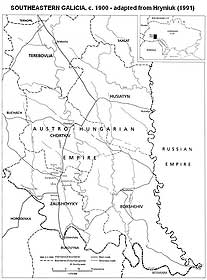 In
1880, the total population of southeastern Galicia –
comprising the counties of Borshchiv, Chortkiv, Husiatyn,
Terebovlia, and Zalishchyky – was just over 360,000.
About 65-70 percent of the population was Ukrainian, about
16-20 percent were Poles, and 14 percent were Jews (1). In
1880, the total population of southeastern Galicia –
comprising the counties of Borshchiv, Chortkiv, Husiatyn,
Terebovlia, and Zalishchyky – was just over 360,000.
About 65-70 percent of the population was Ukrainian, about
16-20 percent were Poles, and 14 percent were Jews (1).
Four-fifths of the population was primarily dependent on
agriculture and forestry for its livelihood. Four grain crops
– wheat, rye, barley and oats – predominated.
In Zalishchyky county, which included Tluste, maize was also
widely cultivated; and tobacco growing was also said to be
profitable. The relatively mild climate and rich soil in the
vicinity of Zalishchyky town, 25 km south of Tluste, also
favoured the cultivation of high-revenue crops such as early
ripening tomatoes, apricots and grapes.
The remaining one-fifth of the population, mainly inhabiting
small towns, provided services to the rural areas (i.e. industry
and crafts, commerce and transportation, non-agricultural
day labour, and government administration). 
Social structure
Southeastern Galicia, also referred to by some as “Southern
Podillia”, was a region of marked social contrasts.
It was said that “[g]reat mansions shared the countryside
with the villages of the peasants and the largely Jewish market
towns; large and very large estates adjoined the small plots
of the peasantry” (2).
Tluste was absolutely typical in this regard. In 1880, Tluste
had a modestly growing population of about 3,300 citizens:
two-thirds Jewish, one-fifth Ukrainian and about one-tenth
Polish (see also: Census Data).
Along with about 20 other towns of southeastern Galicia, Tluste
was large enough to be granted the status of “market
town”. This status was officially conferred upon suitable
communes by the imperial (Austrian) authorities and, after
1859, at the county level (3).
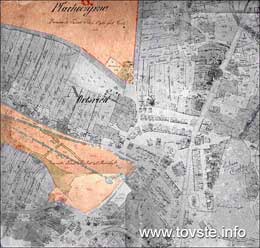 |
In 1891, the major landowner in Tluste
was a Polish nobleman by the name of Prince (i.e. Fürst,
in German) Poninski, who owned a mansion and a farm.
A map of Tluste from 1858 reveals two large tracts of
land in the Poninski name – one starting about
200 m west of the Roman Catholic church, and the other
large tract located north-northwest of the town's cemetery.
It is speculated that Prince Poninski may have lived
in what some call today the “Polish
palace”, a formerly elegant building situated
southwest of the town reservoir. |
Poninski's immediate predecessor, at the end of the 18th
century, was another feudal lord by the name of Slonetskiy.
The nearby villages of Anielowka, Karolowka, and Rozanowka
are reportedly named after his three daughters - Aniela, Karola
and Rozalia - while modern-day Slone, a few kilometres southwest
of Tovste, bears his own name.
The interaction of these nobleman with the local community
is an area of research in need of further investigation, however
Hryniuk offers some general insights in this regard (4).
“The wealth of the large landowners was reflected in
their political pre-eminence. Their power was feared; they
received deference, but rarely respect and admiration. They
lived separate from the people in every way. In their mansions,
their children were tutored privately while village children
went to the local school”. 
Peasant life
Life was rather different for the Ukrainian peasantry. It
was still customary, towards the end of the nineteenth century,
for three generations of a Ukrainian family to live in a single
dwelling (i.e. a married son, with wife and children, living
together with the parents).
| A typical house was built of logs and beaten
clay mixed with straw, with a roof made of thatched straw.
It was not uncommon for this simple, but durable construction
to last more than a century, if built properly. Indeed,
even in Tovste today one finds remnants of such houses
still standing – perhaps transformed, with roofs
made of modern construction materials; or, if no longer
used as dwellings, assigned to animals or for storage.
|
|
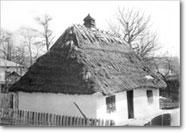 |
In his marvellous account of Galician life, Generations:
A Family History, Picknicki describes the construction
of these traditional village houses (khata or khalupa)
in considerable detail (5).
Typically they had only one or two rooms – the living
area and a storage room or komora. A huge clay oven
(pich), white-washed and attractively decorated,
dominated the interior. The floors were made of packed clay
and the furnishings were very modest.
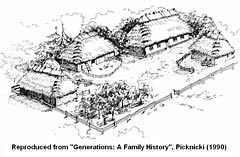 |
|
A typical farmyard would have had a barn,
used for threshing and storing sheaves of grain; a stable
for the animals; and other structures such as a sty and
a chicken coop, a well or a cellar. According to Ukrainian
custom, the yard would always be fenced.  |
Commerce
A Galician business directory published in 1891 offers a
glimpse of what Tluste was like in those days (6).
As shown in this table
compiled and adapted from the original directory, three guesthouses
and a café were operating – more than can be
said for the availability of accommodation one hundred years
later in modern-day Tovste! There were a relatively small
number of professionals in town: a lawyer, a notary, two druggists,
an architect/master builder, and three business agents. A
brick works was already established and there were two mills
operating. A half-dozen dealers supplied Tluste and nearby
villages with metal, leather, wood and building materials.
A dozen or so trades were each represented by at most one
or two craftsmen (e.g. in cabinet making, carpentry, metal-working,
shoemaking, tailoring, watch-making, weaving etc.). In this
regard, there seemed to be little choice – and little
competition – in the town.
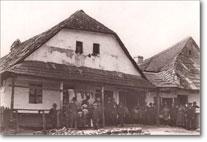 |
There was a small retail sector offering,
among other things: books, art and music; drapery, linen
and underwear; fashion accessories; glass and china; and
notions and materials (fabrics). The food sector was adequately
represented by three grain and produce dealers, three
egg dealers and importers, two grocery/delicatessen shops,
dealers in flour and wine, as well as a butcher and a
baker. |
As reported in Austrian census figures for 1900 (7),
Tluste was also home to a district court, a tax office, a
finance oversight office, as well as four saving and lending
institutions. The town was served by its own volunteer fire
brigade and five gendarmes.
In that year, it was reported that Tluste had both Greek
Catholic and Roman
Catholic parishes, as well as a Jewish Community organisation
(Israelitische Kultusgemeinde), whose members worshipped
at the town synagogue.
There were two Level-VIII elementary schools, evidently needed
to accommodate an ever-increasing number of young children
being born into the community. In addition to the two resident
doctors and apothecary in town, there were no fewer than six
registered midwives, and a veterinary surgeon. 
Transport network
Tluste had the advantage, already in 1880, of being fairly well connected within
the regional road network, which was then the predominant
mode of transportation for people and goods. The town was
situated on an “imperial highway” that was built
in the late eighteenth century and traversed Eastern Galicia.
Built from a base of crushed stone and a gravel surface, the
road ran northward from Chernivtsi through Zalishchyky, and
onward to Chortkiv, Ternopil and eventually Lviv.
Major upgrading was undertaken on this and other highways
around 1887, on account of their military significance. In
that year, a new iron road bridge was built across the Dniester
river at Zalishchyky. In general, road construction and maintenance
was done though a compulsory labour scheme, which committed
villagers to work as many as six days per year. This was eventually
reduced to two days per annum in 1896. Adding to the chagrin
of the villagers, private entrepreneurs had contracts to collect
tolls on many of these roads (8).
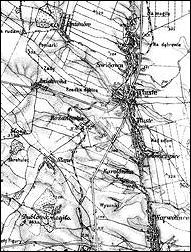 In
the 1890s, the Galician parliament (Sejm) took interest
in fostering and financing the construction of local railways.
Several new lines were built in the last few years of the
nineteenth century, including a 51 km section that began just
west of Chortkiv and ran south through Tluste to Zalishchyky. In
the 1890s, the Galician parliament (Sejm) took interest
in fostering and financing the construction of local railways.
Several new lines were built in the last few years of the
nineteenth century, including a 51 km section that began just
west of Chortkiv and ran south through Tluste to Zalishchyky.
Construction of this portion of the network began in 1897
and was completed in 1901. The map, opposite, traces the route
as it snakes through Tluste. The chosen path, to the west
of town, required the expropriation of property from a number
of landowners. A two-story railway station was completed in
1899.
It has been reported that the construction of the railway through Tluste was overseen
by Józef Potyra, a Galician of Polish descent. Though he did not originally come from Tluste, a large monument bearing his name can be found in the old cemetery. (9).
| |
|
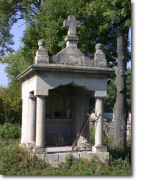 |
His descendants have reported that he travelled several times to the United States, where he may have been involved in various bridge construction projects and/or coal mining in the state of Pennsylvania.
After returning to Tluste, Józef Potyra purchased land for the construction of a flour mill. He is reported to have died of heart failure in 1944, at the age of about 84. The fact that he was married to a countess by the name of Filomena Dolinska, 17 years his junior, might help to explain the extraordinary monument that was erected in his honour. |
The construction work on the railway created opportunities
for manpower and suppliers of building materials, boosting
local economies for at least a few years. It is reported that
there was resentment among Ukrainians that Poles tended to
benefit more from the employment opportunities created from
the construction boom and later, from the staffing of technical
and professional positions (10).
However, the main economic advantage of the railways was seen
in the rapid growth in the number of passengers and freight
that they carried in the first few years of their operation.
Situated on the imperial highway, Tluste was also a hub for
regional postal and telegraph services. Along with neighbouring
Zalishchyky and Chortkiv, Tluste had a postal stable and stage
point already in 1880. By then, the town also had its own
post office and electric telegraph facility. The postal stable
was still in place at the turn of the century (11). 
Galician educational system
It is worth digressing briefly to examine the prevailing
educational system and health care issues that impacted the
lives of the citizens of Tluste.
Hryniuk (12)
reports that when Eastern Galicia was incorporated into the
Austro-Hungarian Empire in 1772, the Greek Catholic (Uniate)
clergy had been the main educators in the villages. However
the clergy’s own standard of learning was low. Empress
Maria Theresa (1717-1780) and her successor, Emperor Joseph
II (1741-1790) both recognized their importance and provided
opportunities to enhance their educational competence. Each
village was to have a ‘trivial’ or primary school
and there was to be compulsory education for children 5-12
years of age.
In fact, the stated goal of compulsory education was not
realised. During the nineteenth century, however, there was
a steady increase in the number of church-administered schools
in Galician villages, in particular after substantial autonomy
was granted to the region following the Austrian constitutional
transformation of 1867.
Nevertheless, the education system was still lacking in southeastern
Galicia and it was in Zalishchyky county that the least progress
was made. Between 1880 and 1900, the number of public elementary
schools actually declined from 44 to 38. It was the only county
in which one-teacher schools were still preponderant in 1900.
| On the positive side, a new elementary school
for Jewish boys opened in Tluste, supported by the Baron
Hirsch foundation, and it accounted for much of the increase
in the county’s school enrolment during the last
decade of the nineteenth century. There was also a specialised
school in Tluste that provided training in ceramics. |
|
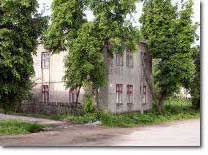 |
The language of instruction in schools was often Polish,
a source of complaint among Ukrainians in predominantly Ukrainian
areas. Tluste had a four-teacher public elementary school,
but there was only one parallel class in which Ukrainian was
the teaching medium. More generally, the education system
was beset by such problems as too few teachers, overcrowded
schools, and few opportunities for regular progression from
elementary to secondary and higher levels of education. There
was, for example, no secondary school in all of southeastern
Galicia in the latter part of the nineteenth century (13).
According to Hryniuk, the landowning Polish gentry “sought
to expand greatly the availability of elementary education
in the Land, but to restrict the actual amount of education
in the villages to whatever the one-teacher school could provide.
Peasants were to be made just literate, but further schooling
was to be avoided for fear that a more advanced education
would lead to the peasants getting ideas above their station
in life… Teachers were bound to teach only the assigned
curriculum. They were to cultivate the development of obedient,
hard-working people, and not much else.” (14).
Austrian statistics on the extent of literacy in southeastern
Galicia paint a rather dismal picture, especially in Zalishchyky
county, where the literacy rate between 1880 and 1900 was
the lowest of the five counties. In 1880, just 7.7 percent
of males and 4.1 percent of females were literate. Though
these numbers increased to 20.2 percent and 12.8 percent,
respectively, by 1900, the illiteracy rate was obviously heavily
influenced by the number of people who had grown into adulthood
before large-scale public schooling began in the region. Those
who had received their schooling in the 1890s fared considerably
better (15).
Aside from formal public education, there were other avenues
for educating the public such as: enlightenment societies
(among them, ‘Prosvita’ and ‘Kachkovsky
Society’); the periodic press (e.g. Batkivshchyna
and the bi-weekly Chytalnia); and popular reading
clubs, which served to convey knowledge by having literate
people read aloud to groups of people who could not read.
There were also ‘Agricultural Circles’ formed
by Polish peasants which featured weekly meetings to discuss
common agricultural problems and reading aloud of the press
(16).
It is possible that official data may overstate somewhat
the extent of illiteracy in Galicia. For instance, it is surmised
that some peasants, when asked by census-takers whether they
could read and write, may have been inclined to answer “no”,
out of fear that they would have to pay some sort of tax.
Also there is anecdotal evidence suggesting that Galician
immigrants to Canada were more literate than some gave them
credit for – many having a command of Polish as well.
Moreover, despite limited opportunities for higher education,
some students evidently did receive advanced instruction and
assistance to carry on their studies elsewhere (17).

Health issues
Following severe epidemics of cholera, smallpox and typhus
in the 1870s, health care in southeastern Galician villages
improved in the last two decades of the century, but only
after communicable diseases had taken a heavy toll. A smallpox
epidemic that killed tens of thousands of people in Austrian
lands in 1873 was met with an intensified preventive vaccination
programme. By 1885, 57 vaccination stations had been set up
in Zalishchyky county alone, where deaths from smallpox tended
to be higher than elsewhere in the region. In 1889, for example,
244 people in the county died from a smallpox outbreak, which
led to the closure of markets, shops and some schools in Tluste
and elsewhere (18).
Cholera was also a persistent problem, appearing in epidemic
proportions over several years in the second half of the nineteenth
century. There was a serious outbreak of cholera asiatica
in the five counties of southeastern Galicia in 1893-95, killing
several thousands of people before the epidemic was gradually
brought under control. Zalishchyky county was declared free
of cholera by December 1894, which allowed for the relaxation
of trade restrictions that had been imposed until then.
Tuberculosis was also fairly widespread, particularly in
Zalishchyky county; and other childhood diseases such as measles,
scarlet fever, diphtheria and whooping cough also took their
toll.
During the last quarter of the nineteenth century, the region’s
health care system was insufficient to cope with these major
health care problems. Although Zalishchyky town had a public
general hospital, with 40 beds treating 400 patients annually,
it was the only one in all of southeastern Galicia. Generally,
the region was poorly supplied with doctors and public health
facilities, apart from vaccination stations and a few public
apothecaries, including one in Tluste. There were actually
fewer doctors in Zalishchyky county through the 1880s and
1890s than there had been in 1873. As the population continued
to grow, the doctor-to-patient ratio worsened. In 1900, southeastern
Galicia had 48 doctors for a civilian population of about
425,000.
More positively, some of the larger towns had certified midwives
to assist at childbirth, independent of doctors. They played
an important role in the health delivery system and may have
been an important factor in keeping the proportion of stillbirths
to live births below the average for Galician as a whole.
In 1900, Tluste had six such midwives (19).
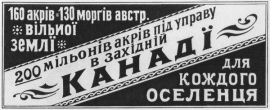 It
was against this backdrop that, from the mid-1890s, Galicia
began to experience a mass emigration of the population –
first to Brazil, and then to western Canada, in the latter
case encouraged by the prospect of owning 160 acres of land
for registration fee of just 10 dollars (about 50 gulden).
Small landowners of 2-5 hectares readily took up the challenge,
despite having to make a substantial investment in the cost
of their transport overseas. In his book, Generations:
A Family History, Picknicki eloquently describes the
origins of Ukrainian emigration to Canada, which was to have
a marked effect on the settlement of western part of that
country (20). It
was against this backdrop that, from the mid-1890s, Galicia
began to experience a mass emigration of the population –
first to Brazil, and then to western Canada, in the latter
case encouraged by the prospect of owning 160 acres of land
for registration fee of just 10 dollars (about 50 gulden).
Small landowners of 2-5 hectares readily took up the challenge,
despite having to make a substantial investment in the cost
of their transport overseas. In his book, Generations:
A Family History, Picknicki eloquently describes the
origins of Ukrainian emigration to Canada, which was to have
a marked effect on the settlement of western part of that
country (20). 
Transformation of Tluste
Notwithstanding the deficiencies in the education and health
care systems before the turn of the century, as well as the
wave of emigration described above, Tluste underwent a remarkable
transformation over the following three decades. Evidence
of a vibrant economic life is suggested in another Polish
business directory, published in 1929 (21).
A table
adapted from that directory reveals an extensive professional,
trade and service sector, alongside a modest manufacturing
capacity.
| |
|
|
| |
At that point, the town’s population
was probably reaching a peak of around 4,000 citizens,
with much the same ethnic balance as described earlier.
The mayor was Marcin Kobiernik, whose initials can be
found on the building that served then as the town hall
(constructed in 1925, and pictured opposite); and which
still stands in the centre of town, serving as a commercial
bank. |
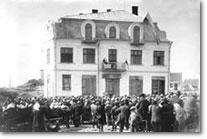 |
By 1929, the Makowiecka family had become the major landowners
in Tluste, also owning the brickyard and one of the town’s
five mills. Among the professionals in town, there were three
doctors, three midwives, a pharmacist and a veterinary surgeon.
The increasingly sophisticated local community attracted no
fewer than five solicitors to set up practice, in addition
to the local notary.
| |
|
|
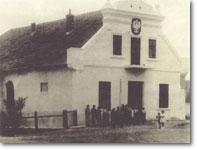 |
|
Tluste now had its own cinema, ‘Swiatowid’
(pictured here); a cooperative society, ‘Narodny
Dim’; and a single saving and lending bank,
‘Zwiaek Kredytowy’.
There were three hotels, an equal number of restaurants,
and five taverns licensed to sell alcohol. |
The expansion of activity in and around Tluste brought with
it an influx of new trades people as well. As compared to
the situation in 1891, several new trades were represented
in 1929. Most significantly, there were often several skilled
craftsmen performing the same function – suggesting
a high demand for their services. Dealers in raw materials
(such as coal, glass, iron, leather, oils and lubricants,
and wood) and hardware, including agricultural implements,
were plentiful.
The retail sector also grew markedly,
with many more shops selling fabrics, fancy goods, footware
and ready-made clothing.
In the food sector, there were no fewer than ten butcher
shops in town, in addition to two bakeries, as well
as dealers in cattle, poultry, corn and fruit.
|
|
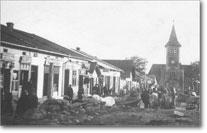 |
It is interesting to search for continuity in families and
their businesses between the directories of 1891 and 1929.
Indeed, one finds several families who appear to be represented
in both directories, though one cannot be absolutely certain
without further research that it is not another family with
the same name. In a few cases, successive generations are
seen to continue the family tradition in a particular trade.
Very often, though, the younger generation appears to have
found a new vocation. 
Family ties
Examples of families associated with Tluste over these several
decades include the following:
SPITZER
The Spitzer family had a very long association with Tluste
that can be documented as far back as 1846 (22).
In that year, Jankel Spitzer was recorded as owning property
in under the title of House no. 3. Judging from the number,
it was probably located right in the centre of town. A half-century
later, the 1891 business directory indicates that M. Spitzer
was a dealer in building materials. This tradition continued
through 1929, with two members of the Spitzer family (Hirsch
and one other unnamed individual) practicing the same trade.
In addition to these two men, J. Spitzer was a dealer in wood,
K. Spitzer owned a confectioner’s shop, and P. Spitzer
ran one of the town’s five licensed public houses.
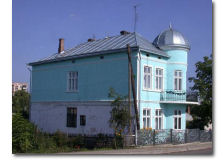 The
Spitzers lived in a large Baroque-style house, built in 1932,
on what is today Hrushevskoho Str. The
Spitzers lived in a large Baroque-style house, built in 1932,
on what is today Hrushevskoho Str.
Hirsch Spitzer is said to have been an acquaintance of Anton
Navolskyy, the priest who shepherded the construction
of the Greek-Catholic cathedral after his arrival in Tluste
in 1930 (23).
A dealer in wood and raw materials, Spitzer is reported to
have donated wood for the construction of the church, refusing
to accept payment for it. The transaction is mentioned in
records from the church kept in the Tovste museum.
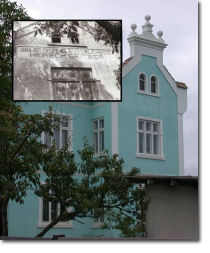 |
The Spitzer house would later be the setting of a
wonderful story of survival through perilous times and
of enduring gratitude towards those who made it possible.
See also: 'The
Spitzer Story'.
Around 2003, the gray house was painted a garish blue
colour and the Spitzer insignia, which had decorated
the upper part of the house for over 70 years, was plastered
over. |
LAGODZINSKI
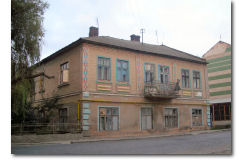 The
Lagodzinski family can also be traced back to 1846 to one
Teodor Lagodzinski, who was a small landowner at the time.
In the 1891 business directory, Ant Lagodzinski was registered
as a gunsmith cum can/tin maker, while A. [L]agodzinski (first
letter thought to be a transcription error) was recorded as
a locksmith / metalworker. By 1929, their offspring, or so
it is presumed, had moved in a completely different direction.
H. Lagodzinski was the owner of one of the town’s three
hotels, while L. Lagodzinski ran a public house licensed to
sell alcohol. The building is still standing today, on the
main north-south thoroughfare, at No. 76 Ukrainska Str. The
Lagodzinski family can also be traced back to 1846 to one
Teodor Lagodzinski, who was a small landowner at the time.
In the 1891 business directory, Ant Lagodzinski was registered
as a gunsmith cum can/tin maker, while A. [L]agodzinski (first
letter thought to be a transcription error) was recorded as
a locksmith / metalworker. By 1929, their offspring, or so
it is presumed, had moved in a completely different direction.
H. Lagodzinski was the owner of one of the town’s three
hotels, while L. Lagodzinski ran a public house licensed to
sell alcohol. The building is still standing today, on the
main north-south thoroughfare, at No. 76 Ukrainska Str.
GÄRTNER & LANGHOLZ
Two families recorded in the 1891 directory, Gärtner
and Langholz, both appear to have had a long-standing connection
to Tluste’s business community. Schewa Gärtner
was the lone baker in town in 1891, while in 1929 his descendants
or relatives were involved in the trade of fruit and mixed
goods, as well as building materials. A. Langholz was one
of three guesthouse/innkeepers in 1891. One of the descendants,
Ch. Langholz continued in this tradition, as proprietor of
a public house with spirit licence, while K. Langholz was
a book dealer and an F. Langholtz (slight spelling difference)
was a brazier.
* * *
There are indications of generational continuity in particular
trades among at least three other families, spanning nearly
four decades: family Horowitz (in carpentry);
Pohorille (in ironmongery); and Reinisz
or Reinisel (in book binding). Among the
other families – most of them Jewish – evidently
figuring in both directories over the 38 years (some with
slight spelling variations), were: Buchhalter,
Einhorn, Fiderer/Fiederer,
Hertman, Katz, Klein,
Kramer, Meiman/Maiman,
and Platzker.
In terms of the historical genealogy of the town, one can
also identify the names of Ukrainian and Polish families with
centuries-long connections to Tluste, some going at least
as far back as the mid-1700s, and still present today through
many generations of descendents. Among them: Badlo,
Chajko, Kowalczuk, Maydanyk,
Melnyk, Slobodian, Smutylo,
Szuturma, Trakalo, and Tymus.
These will form part of a more detailed study at a later stage.
In summary, by the early 1930s, Tluste was a thriving market
town in southeastern Galicia. Zalishchyky,
its neighbour to the south, had by then established itself
as an appealing resort town in its own right, attracting tourists
to its beaches and boardwalks from other parts of Poland.
Tluste had survived the First World War, including a brief
occupation by Soviet forces; it had made it through the scourge
of communicable diseases of the latter part of the nineteenth
century; and gradual improvements in public health and education
were being manifested in lower mortality rates and increased
literacy.
It is perhaps not a coincidence that little appears to have
been written about Tluste in the 1930s. Things were going
well, and normal life was not fodder for introspective news
coverage. Of course, the turn of events at the end of that
decade would profoundly alter the landscape of Tluste forever. 
Notes:
(1) Hryniuk, S. Peasants with Promise: Ukrainians
in Southeastern Galicia 1880-1900. Edmonton, 1991. p.
31
(2) Ibid. p. 18
(3) Ibid. p. 58
(4) Ibid. p. 18
(5) Picknicki. J. Generations: A family history.
Winnipeg, 1990. p. 103-5
(6) The 1891 Galician Business Directory (Kaufmannisches
Adressbuch für Industrie, Handel und Gewerbe, XIV.
Galizien, published by L. Bergmann & Comp., Wien IX, Universitutmetr.
6); last accessed on 14 August 2005 at: https://www.jewishgen.org/databases/Poland/galicia1891.htm
(7) Special Orts-Repertorien von Galizien. Bearbeitet
auf Grund de Ergebnisse der Volkszählung vom 31. Dezember
1900. K.K. Statistischen Central Commission. Wien, 1907.
p. 758
(8) Hryniuk, S. Peasants with Promise: Ukrainians
in Southeastern Galicia 1880-1900. Edmonton, 1991. p.
41-5
(9) Pawlyk, J. pers.comm., 2005
(10) Hryniuk, S. Peasants with Promise: Ukrainians
in Southeastern Galicia 1880-1900. Edmonton, 1991. p.
52
(11) Ibid. p. 55
(12) Ibid p. 64-69
(13) Ibid. p 74-77.
(14) Ibid. p. 65-66
(15) Ibid. p 78-80
(16) Ibid. p. 86-107, 128
(17) Ibid. p 79-80
(18) Ibid. p 173
(19) Ibid. p. 180-81
(20) Picknicki, J. Generations: A family history.
Winnipeg, 1990. p. 53-55
(21) Ksiega Adresowa Polski (Wraz z w.m. Gdanskiem dla
Handlu, Przemyslu Rzemiosl l Rolnictwa) – Directory
of Poland, including Gdansk, for trade, industry, handicraft
and agriculture (1929); last accessed on 14 August 2005 at:
https://www.jewishgen.org/jri-pl/bizdir/start.htm
(22) 1846 Summary of Landownership records for Czortkower
Kreis- Markt Tluste; consulted at Central State Historical
Archives of Ukraine, Lviv, in July 2001.
(23) Pawlyk, J. pers.comm., 2005 
|

